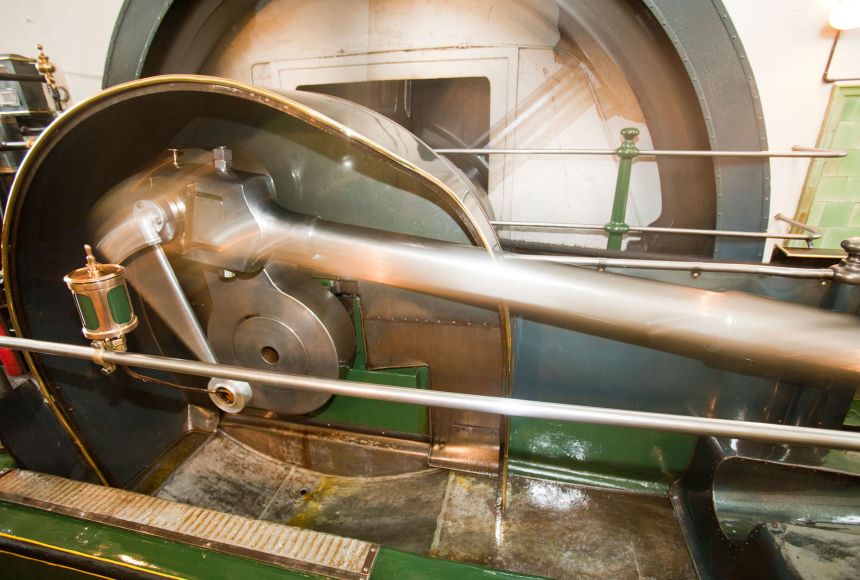The Industrial Revolution (1750–1850) was perhaps the most significant transformation in human history, because of its wide-ranging effect on people's daily lives. It began in Great Britain and then spread to other European countries and the United States. A huge variety of new tools and machines were first introduced during this period.
Below are some key examples of the important changes that occurred.
Agriculture
Western European farming methods had been improving slowly over the centuries. Several factors came together in 18th-century Britain to bring about a major increase in agricultural productivity. These included new types of equipment, such as the seed drill. Progress was also made in crop rotation and land use, soil health, development of new crop varieties, and animal farming. The result was a huge increase in yields, capable of feeding a rapidly growing population.
This same combination of factors also brought about a shift toward large-scale commercial farming. Poorer peasants had a harder time making ends meet through traditional farming. The enclosure movement, which converted common-use pasture land into private property, contributed to this trend toward market-oriented agriculture. A great many rural workers and families were forced to migrate to the cities to become industrial laborers.
Energy
Deforestation in England had led to a shortage of wood for lumber and fuel starting in the 16th century. The country's transition to coal as a principal energy source was more or less complete by the end of the 17th century. The mining of coal set in motion some of the factors that led to Britain's industrialization. The coal-fired steam engine was in many ways the key technology of the Industrial Revolution.
Steam power was first used to pump water out of coal mines. For centuries, windmills had been employed in the Netherlands for the roughly similar operation of draining low-lying flood plains. However, wind's irregularity was considered to be a drawback. Water power was a more popular energy source for grinding grain and other types of millwork in most of preindustrial Europe. By the last quarter of the 18th century, however, steam engines had been perfected, thanks to the work of the Scottish engineer James Watt.
The steam engine swiftly became the standard power supply for British, and, later, European industry. It turned the wheels of mechanized factory production. Its emergence freed manufacturers from the need to locate factories near sources of water power. Large enterprises began to concentrate in rapidly growing industrial cities.
Metallurgy
Many valuable metals can be found in the metal-bearing rock known as ore. Metallurgy is the process of extracting, or removing, that metal through heating and melting, or smelting. Metal that has been heated to the melting point is called molten. Metallurgy also involves the shaping and modification of extracted metal.
Metallurgy had existed for thousands of years before the Industrial Revolution. However, it too saw big changes during this period. Britain's wood shortage forced a switch from wood charcoal to coke, a coal product, in the smelting process. The substitute fuel eventually proved to be highly useful for iron production.
Experimentation led to some other advances during the 1700s. For example, a new type of furnace that kept coal from mixing with the metal made it possible to produce larger amounts of wrought iron. So did a new process of "puddling" or stirring the molten iron. Wrought iron is more malleable, or moldable than cast iron. That makes it more suitable for fabricating machinery and other industrial uses.
Textiles
The production of fabrics, especially cotton, was key to Britain's economic development between 1750 and 1850. Cotton production had long been a small-scale cottage industry, in which rural families wove and spun cloth in their homes. During the years of the Industrial Revolution, it transformed into a large, mechanized, factory-based industry.
The boom in productivity began with the invention of a few technical devices. Among them were the spinning jenny, the spinning mule, and the power loom. The introduction of steam power also transformed the production of textiles. Steam power was used to operate power looms and other specialized equipment. Another well-known invention was the cotton gin, invented in the United States in 1793. The cotton gin is a machine that quickly and easily separates cotton fiber from their seeds. This device led to an increase in cotton cultivation in U.S. slave states.
Chemicals
The chemical industry developed rapidly during the years of the Industrial Revolution. It arose partly in response to the demand for improved bleaches to whiten cotton and other textiles. Other chemical research was motivated by the quest for dyes, dissolving agents, fertilizers, medicines, and explosives.
Transportation
Huge increases in production led to a need for better transportation systems. Producers needed faster and more efficient ways to get their goods to market. As a result, improved roads were constructed in Europe. Canals were dug in both Europe and North America to connect existing waterways.
The potential of steam engines to power transportation was quickly recognized. The first steamboats emerged in the early 19th century. Steam engines also powered railroad locomotives, which were running in Britain after 1825. Railways spread rapidly across Europe and North America. Railroads became one of the world's leading industries as they expanded the frontiers of industrial society.

